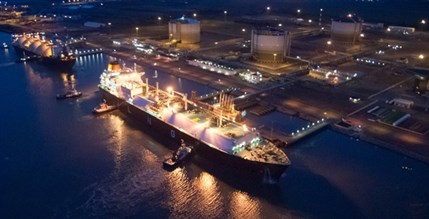Shipping industry looks to LNG to cut sulfur emissions

Photo courtesy of Engie.
(Reuters) The global shipping industry is bracing for a key regulatory decision that could mark a milestone in reducing maritime pollution, but which could nearly double fuel costs in a sector already reeling from its worst downturn in decades.
The shipping industry is by far the world's biggest emitter of sulfur, with the SOx content in heavy fuel oil up to 3,500 times higher than the latest European diesel standards for vehicles.
To combat such pollution, the International Maritime Organization's (IMO) Marine Environment Protection Committee will meet in London on October 24-28 to decide whether to impose a global cap on SOx emissions from 2020 or 2025, which would see sulfur emissions fall from the current maximum of 3.5% of fuel content to 0.5%.
"One large vessel in one day can emit more sulfur dioxide than all the new cars that come onto the world's roads in a year," said Thomas Koniordos, head of business line environmental solutions at Norway's Yara International.
"That is reason enough to cap emissions," added Koniordos, whose firm makes scrubbers used to clean exhaust emissions.
Large container ships can consume up to 300 tons of high-sulfur fuel a day at sea, while a 300,000 deadweight tons (DWT) supertanker guzzles up to about 100 tons per day.
The issue has been brewing for more than a decade and shippers said the industry was now bracing for tighter regulation to be introduced sooner rather than later due to political pressure.
"The decision will likely be a political one - the European Union is pressing strongly for 2020," said Arthur Bowring, managing director of the Hong Kong Shipowners' Association.
The European Union has already agreed that the 0.5% sulfur requirement will apply in 2020 within 200 nautical miles (370 km) of EU Member States' coasts, regardless of what the IMO decides.
China, home to the world's busiest container ports, is also demanding cleaner fuels.
Authorities in Shenzhen, the world's third biggest container port, introduced tighter controls this month, demanding that ships calling there do not use fuel with a sulfur content of more than 0.5%.
Ship owners can comply with the tighter controls either by switching away from the sludgy and sulfur-rich so-called bunker fuels to diesel or LNG, or by fitting scrubbers to clean exhaust emissions.
A fuel-switch would impose extra costs on an already troubled shipping sector, which has seen high-profile defaults like South Korea's Hanjin as well as cases of stranded ships with crew left onboard ships unpaid and unsupplied.
Using low-sulfur diesel instead of bunker fuel on a very large crude carrier (VLCC) class supertanker would boost fuel costs by around 44% from an average of $212/ton this year for heavy fuel oil to $379/ton for gas oil, according to figures from shipping broker Clarkson.
For traded oil markets, the shift to low-sulfur fuel will "substantially reduce demand for bunkers in the run up to 2020 and increase demand for gasoil and alternative fuels including LNG," said Christopher Haines, head of oil and gas at BMI Research.
By Roslan Khasawneh and Keith Wallis; Editing by Henning Gloystein

- ExxonMobil halts 1-Bft3d blue hydrogen project in Texas
- Aramco and Yokogawa commission multiple autonomous control AI agents at Fadhili gas plant
- Ukraine will resume gas imports via Transbalkan route in November
- Mitsubishi to inject $260 MM into Brunei LNG project
- Freeport LNG (U.S.) on track to take in more natgas on Thursday after unit outage



Comments